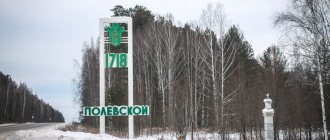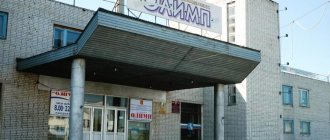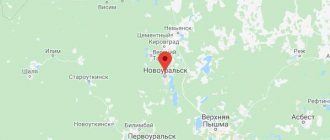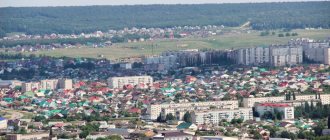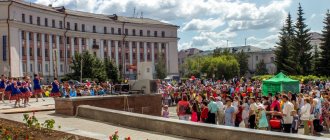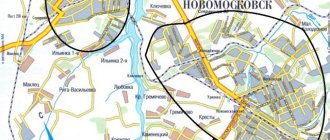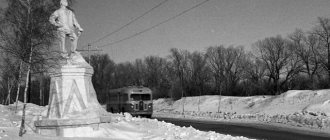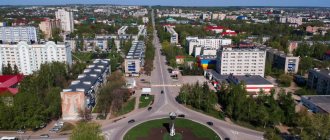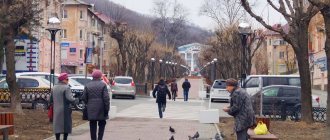Meleuz on the map of Russia, geography, nature and climate
Looking at the position of Meleuz on the map of Russia, you can see that the city is located at the western foot of the Urals, at the confluence of the Meleuz and the Belaya , on the left bank of the latter. The distance from here to Ufa is 225 km, to Orenburg 156 km.
On the satellite map of Meleuz you can see that the city is located in the steppe region. The city's vegetation consists mainly of typical weeds. There are practically no territories occupied by sedate meadows or deciduous forests.
Sights of the city of Meleuz
Monuments and memorials in the city that are worthy of attention:
- Walk of Glory and a monument with an installed Eternal Flame - a monument to the soldiers who fell during the Great Patriotic War (1941-1945);
- memorial complex “ Fighters of the Revolution for Soviet Power ”;
- marble stele in honor of internationalist soldiers who died in the line of military duty in local armed conflicts in Afghanistan.
Other attractions in Meleuz and the surrounding area:
- Kuperlya waterfall and a karst bridge 27 km from the city (the remnant of the destroyed roof of the Kuperlya underground river bed, about 4 m wide and 35 m long);
- The huge Nugush reservoir;
- Copper smelter named after. Pugacheva and the Resurrection Church in the village of the same name;
- Partisan Museum and Literary Museum named after. D. Bulyakova ;
- Central Square (Vorovskogo Street), cultural park "Slava" and park named after. Gagarin.
Meleuz
(Republic of Bashkortostan)
OKATO code:
80425
Founded:
2nd half.
18th century Urban-type settlement since:
1938
City since:
1958 City of district subordination (Meleuzovsky district of the Republic of Bashkortostan)
Center:
Meleuzovsky district
Telephone code (reference phone)
| 34764***** | 40-20-5 |
Deviation from Moscow time, hours:
2
Geographic latitude:
52°57′
Geographic longitude:
55°56′
Altitude above sea level, meters:
170 Sunrise and sunset times in the city of Meleuz
Main Streets of Meleuz
Looking at the map of Meleuz with street names, you can see that the city has a large number of streets, avenues, squares, and parks. Let's look at the main ones.
Smolenskaya street
This long street starts from the intersection of the street. Burangulova from st. Lenin and passes through the entire Meleuz. It intersects with the street. Tsyurupy, st. Oktyabrskaya, st. 50 years of VKLSM, st. Beregovoi and more. At its beginning there is a branch of the Moscow State University of Technology and Management in Meleuz.
st. Lenin
This street runs perpendicular to the street. Smolenskaya. It runs through the Memorial with the Eternal Flame, the Park of Glory and the State Museum of History and Local Lore. St. Lenina starts from st. Lesokombinatnaya and ends at the intersection with the street. State Farm. It also passes through the Meleuz River and such streets as: Yuzhnaya, Dokovskaya, Slavnaya and Promyshlennaya.
Beregovaya Street
This street starts from st. Spiridonov and ends at the intersection with the street. Smolenskaya. The street intersects with the street. Sinitsyna, st. Vorovskogo, st. Pushkina, st. Spiridonova, st. Gagarina and st. Parkovaya.
Pervomaiskaya street
This small street runs parallel to the street. Smolenskaya. It starts from the street. Lenin and ends at the intersection with the street. Tsyuryupa. The street passes through it. Oktyabrskaya and st. Bauman, and next to it is the Park of Glory and the Central Children's Library.
Boulevard of Glory
This small section of the city is located between the street. Vokzalnaya and st. Lenin, next to the Meleuz Railway Station. The Khimik stadium is located nearby.
In total, on the detailed map of Meleuz with houses you can count more than 6533 different buildings.
Meleuz – its past, present and future
Bakurov, B. Meleuz - his past, present and future [Text] / B. Bakurov
// The Path of October. – 1979. – March 15. – P. 2.
FOR THE COMPETITION
Bashkiria is the pearl of the Urals. Just as a young apple tree gains strength and every year its fruits become more abundant and larger, so Bashkiria is gaining strength. Its cities are growing, becoming more beautiful and richer. Ufa, Sterlitamak, Birsk, Salavat, Ishimbay, Oktyabrsky, Kumertau, Belebey, Uchaly and among them the youngest city of the republic - Meleuz. The city is young, but has a long history.
No one can say exactly when a settlement arose on the site of the city, but people have lived in the valley of the White River since ancient times: an Old Stone Age site near the village of Beregovka, which is 20 km away. from Meleuz, drawings of an Old Stone Age man in the Kapova Cave.
Meleuz was founded around the first half of the 18th century on a highway as a Yamsk postal point. The first settlers of Meleuz were Bashkirs, Russians, Chuvash, Tatars, who were engaged in agriculture and pottery. Goncharnaya Street got its name from the pottery workshop that was located on it. Kuznechnaya Street received its name from the artisans who lived on this street - blacksmiths. Meleuz became a large village at the end of the 19th century. Since 1880, it has been the center of a brisk trade in timber, sponge, sleighs, wheels, bread, salt, fish, and livestock.
The lands around Meleuz are famous for their fertility. Peasants brought grain here to sell. And in 1910, the merchant Popov from Orenburg built a large five-story mill in Meleuz, which produced 600 pounds of first-class flour per day. On barges, and in the spring flood on steamships, flour was floated to Ufa and beyond.
Before the revolution in 1917, there were 897 farms in Meleuz, including 523 landless ones - artisans, potters, wheelwrights, joiners, carpenters and others.
4,728 people lived here, including 17 teachers, 500 students, and three paramedics. In the village there were two churches, a mosque, two primary church schools, a men's gymnasium, a higher primary school, one private gymnasium, a library, and a medical assistant's station.
The Great October Socialist Revolution raised the working people to fight. The Meleuzovsky volost revolutionary committee is being organized. Mikhail Aleksandrovich Spiridonov was elected chairman of the revolutionary committee. The members of the revolutionary committee were Idrisov Ibragim Yagafarovich - a farm laborer, Pyotr Stepanovich Kutovoy - a sailor who took part in the storming of the Winter Palace, Pavel Matveevich Kochkin - an artisan potter and others.
The Meleuz Revolutionary Committee organized the registration of volunteers into the Red Guard and sent them in groups to the city of Sterlitamak. More than 60 people signed up for the Red Guard. Ermolaeva Pelageya Nikitichna - one of the representatives of the Red Guards, lives in the city of Meleuz, in the 32nd microdistrict, house No. 34, apt. 3. The headquarters of the Red Guard was first located in the premises of the volost executive committee (the building of the old hospital), and then in the house of the merchant Usmanov, and a detachment of the Red Guard was also located there (now evening school No. 1 is located here).
In November 1917, a volost congress was convened. The bourgeoisie, under the leadership of the merchants Melnikov and others, tried to disrupt the work of the congress and raise a rebellion, but was dispersed by the Red Guards of I. N. Syrov’s detachment. From December 1917 to May 1918, much work was done to create new government bodies for the working people.
In February 1918, in the premises of the cinema. N.K. Krupskaya held the 2nd volost congress. M. A. Spiridonov was elected chairman of the volost executive committee, and I. Ya. Idrisov was elected deputy chairman. Member of the executive committee I.N. Krylov was appointed military commissar of the volost.
The rebellion of Ataman Dutov in the Orenburg province led to the temporary overthrow of Soviet power. At the end of June 1918, the troops of Ataman Dutov entered Meleuz. Members of the volost executive committee were arrested and beaten with whips. The leader of the Meleuzov youth, the secretary of the volost executive committee, Konstantin Nikitovich Vokhmin, was killed by a guard soldier. In August 1918, the White Guards shot three more Red Guards: Gleb Vasilyevich Napolsky from the village. Bugulchan, Voronkova Alexander Nikitovich from the village. Troitskoye, Muslimov Shakir Muslimovich from Makrovskaya volost. They shot the Red Guards on the edge of the village (now there is a hatchery station there).
The defeat of Ataman Dutov's rebellion in Orenburg weakened the forces of the counter-revolution. In December 1918, soldiers of the Smolensk regiment of the Samara Iron Division drove the Whites out of Meleuz. Soviet power was restored here. The Volost Executive Committee began its work. Smolenskaya Street was named in honor of the Smolensk Regiment. The killed Red Guards were buried near the building of the volost executive committee, where now there is a monument to those killed in the civil war. On the monument are the names of the fighters for the establishment of Soviet power.
Kolchak’s offensive in March-May 1919, the capture of Ufa, Bugulma, and Buguruslan by Kolchak’s troops complicated the situation in Bashkiria. Kolchak's troops occupied Meleuz. The offensive of the Red Army under the command of M.V. Frunze led to the defeat of Kolchak’s troops and their retreat. On May 27, 1919, Kolchak’s troops were driven out of Meleuz. Soviet power was finally established in Meleuz. TOZs are formed - partnerships for joint cultivation of land, supply and marketing cooperatives.
In 1928, the “May 1 Commune” arose in Meleuz, uniting 24 households. The commune had 12 horses and 5 plows. The first chairman was Rakhmatullin Mukhamet Galeevich. The state provided assistance to the communes - it provided seeds. The peasants understood the need to create collective farms.
On April 3, 1929, the Smychka collective farm was organized in Meleuz; it united 510 households. The chairman of the collective farm was the communist Georgy Alekseevich Smolin.
On August 20, 1930, Meleuz became the center of the district of the same name. By this time, collectivization covered 35.6 percent of peasant farms. A machine and tractor station is being created in Meleuz.
The successes of collectivization led to fundamental changes in Meleuz and the region. By 1936, the social composition of society consisted of peasants, collective farmers, workers and the working intelligentsia. The idea of building socialism embraced all segments of the population and contributed to the victory of the socialist worldview among people. Residents of the village of Meleuza and the region celebrated the adoption of the 1936 USSR Constitution, the constitution of victorious socialism, as a great holiday. In 1937, at the first elections to the Supreme Soviet of the USSR, the workers of Meleuz and the region showed a high level of their political consciousness. Voters cast 99 percent of their votes for candidates from the bloc of communists and non-party members.
The socialist transformation of agriculture contributed to an increase in the yield of collective farm fields, livestock, and an increase in its productivity. There is an urgent need in the area to build a milk processing plant. In 1938, construction of a milk powder plant began. This plant was built by the workers of Meleuz under the leadership of engineer Mikhail Ippolitovich Shishkov (after the Great Patriotic War, he also supervised the construction of the Meleuz elevator, and then headed the Meleuz inter-collective farm construction organization, which built schools, industrial premises, clubs, and industrial complexes in the area).
On April 1, 1940, the plant was put into operation. During the Great Patriotic War, he supplied the Soviet Army with powdered milk, egg powder, butter, and dried potatoes. Turners performed tasks of military significance. Workers - women and teenagers - increased shift production standards by 150-200 percent.
After the war, the plant reconstructed its workshops and increased the range of products - milk powder, cream powder, whey powder, ice cream powder, kefir, fermented baked milk, cottage cheese, butter and other products.
In 1964, the plant was renamed into a milk canning plant, which united a network of head factories and dairy stations in neighboring districts - Fedorovsky, Kumertausky, Kayurgazinsky, Zianchurinsky. In 1950, production output was increased to 1000 tons of dry products per year, in 1978 their output increased to 8595 tons.
Over the years of the first three five-year plans, the village of Meleuz turned into the industrial center of the region, its population increased, and its streets were improved. The population of Meleuz lived an active political life in the country.
The Meleuzites accomplished a great feat at the front and in the rear during the Great Patriotic War. The Meleuzovsky district military registration and enlistment office sent 15 thousand soldiers to the front. The Soviet people defended their freedom and independence. In the fight against the sworn enemy of humanity, 6 thousand of our fellow countrymen gave their lives. Thousands of defenders of the Motherland were awarded orders and medals, 12 of our fellow countrymen earned the title of Hero of the Soviet Union. Three of them are from Meleuz. This is Vasily Ivanovich Sinitsyn - pilot. He made 365 bomber flights.
Hero of the Soviet Union Sergei Nikolaevich Gureev was born in 1918 in the village. Meleuse. After graduating from junior high school, he worked as a mechanic and vulcanizer at Meleuzovskaya MTS. In 1939 he was drafted into the Red Army. Graduated from the Red Banner Military School named after Frunze. He fought on the Bryansk, Steppe, Voronezh and 1st Ukrainian fronts. During the crossing of the Dnieper in September 1943, he commanded a motor ferry and skillfully ensured the crossing of tanks across the Dnieper.
Hero of the Soviet Union Chernykh Nikolai Andreevich was born in 1924. In 1942 he graduated from high school and was drafted into the Red Army. Nikolai Andreevich graduated from the school of machine gunners. At the front he commanded a machine gun crew.
The Meleuzites helped the front with their heroic labor. Women, old people, and teenagers provided all the work on cultivating collective farm fields and operating industrial enterprises. The population of Meleuz and the region took an active part in organizing assistance to the front, not only with their labor, but also with personal contributions.
404,783 rubles were collected for the tank column named after Alexander Matrosov, and 1,282,000 rubles for the squadron of aircraft named after the 25th anniversary of Bashkiria.
During the war years, the population of the city of Meleuz donated 410 short fur coats, 1,713 pairs of felt boots, 267 quilted jackets, and 1,673 individual gifts to the front. During the war years, thousands of evacuated residents from Smolensk, Kharkov, and other cities and villages found housing and a place of work in Meleuz.
(The ending follows).
Bakurov, B. Meleuz - past, present and future [Text] / B. Bakurov
// The Path of October. – 1979. – March 17. – P. 2.
(Ends. Starts at No. 32).
After the end of the Great Patriotic War, industrial construction began at a rapid pace in the working-class village of Meleuz. In 1946, the Meleuzovsky auto repair shops were reorganized into an auto repair plant.
In 1950, the construction of the Sterlitamak-Kumertau railway was completed. Through the Meleuz railway station, building materials - gravel, sand, lumber, timber, carpentry - went to the construction sites of the cities of Kumertau and Salavat.
In 1949 - 1950, a wood processing plant was built - DOK.
Since April 1952, DOK began to produce lumber and joinery for the construction of the southern regions of the republic.
In 1951 - 1954, a new brick factory was built in Meleuz. In August 1954, the products of the first stage of the plant were received. In 1957, the second stage of the plant came into operation. Its initial capacity was 30 million bricks per year. In 1978, the plant team produced 44 million bricks. In 1962, a workshop for the production of mineral wool was built at the plant.
In 1955 - 1957, the Meleuzovsky reinforced concrete structures plant was built. The construction of the plant was declared a Komsomol construction project. In 1957, ZZHBK produced its first products - contact electrical network supports, floor slabs for housing construction, blocks for house construction, and sprinkles worth 200 thousand rubles. In 1970, the plant produced its millionth support. In 1978, ZZHBK produced products worth 10 million 100 thousand rubles.
With the launch of the ZZhBK, the population of the working village of Meleuz increased. In 1958 it was renamed a city of regional subordination.
In 1958 - 1960, the Meleuzovsky sugar factory was built. On October 19, 1960, the plant produced its first products.
For the successes achieved, the staff of the sugar factory was repeatedly awarded the Challenge Red Banner of the Council of Ministers of the RSFSR and the All-Union Central Council of Trade Unions. For several years in a row, the plant has retained the Red Banner of the USSR Ministry of Food Industry and the Central Committee of the Trade Union of Food Industry Workers. According to the results of the All-Union Socialist Competition for the successful implementation of the Ninth Five-Year Plan, the team of the Meleuzovsky Sugar Plant was recognized as the winner and awarded the Challenge Red Banner, the honorary memorial Badge of the CPSU Central Committee, the Council of Ministers of the USSR, the All-Union Central Council of Trade Unions and the Komsomol Central Committee “For labor valor in the Ninth Five-Year Plan.”
In the tenth five-year plan, the plant retains its leading position among other sugar factories of the RSFSR. Based on the pulp waste from the Meleuzovsky plant, a cattle feeding complex of the collective farm named after M. Gafuri was built. In 1968, he fattened 532 head of cattle with a delivery weight of 280 kilograms. In 1978, the complex fattened 12,500 head of cattle with a live weight of 50,000 centners.
In 1929, in Meleuz there was a point for slaughtering cattle, with a capacity of 50-60 heads per day, this point produced 200-300 kg of sausages. In 1959, a modern meat processing plant was built. Now it produces about 40 tons of meat per day, 10 tons of sausages. In 1974, a beer and soft drinks factory was built in Meleuz. In 1978, the plant produced products worth 704,300 rubles.
In Meleuz in the 30s, a bakery with a small capacity was organized. The population of the village mainly provided itself with home-baked bread. The growth of the city required an increase in the production of bread and bakery products.
In 1973, construction of the dairy plant began. In 1975 he gave his first production. The design capacity of the bakery is 33.4 tons per day.
The socialist obligations of the workers of four-time decorated Bashkiria for 1975 included the following: to commission the first stage of the Meleuzovsky chemical plant in the first half of the year.
The construction of the chemical plant was declared a shock Komsomol construction project. In 1975, the first stage of the plant was built. On December 30, 1976, construction of the second stage of the sulfuric acid production plant was completed. Now the plant produces feed precipitate, phosphoric and sulfuric acids. Construction of the plant continues. The plant will supply complex fertilizers to agriculture. The Komsomol took patronage over the construction of the chemical plant, declaring it a shock Komsomol construction project.
Construction chemical The team of carpenters and concrete workers V.V. Sultanov, the team of masons S.S. Bernatsky from SU-6, and the team of masons M.Kh. Yanberdin from SU-2 showed good results in their work.
Along with industrial facilities, cultural and social enterprises were built; in 1955, the House of Culture was built. In 1958 the city was gasified. By decree of the Presidium of the Supreme Soviet of the RSFSR dated March 24, 1977, the city of Meleuz became a city of republican designation.
Now it is a growing industrial city in the southern part of Bashkiria. Large construction of housing, schools, hospitals, and cultural and community facilities is underway.
In 1978, the Meleuzovsky district provided the country with 100,288 tons of grain. The yield was 23.8 centners per hectare.
Meleuz becomes the site of international sports competitions: motorcycle racers from many countries of the world meet on the cinder track of the stadium. All-Union archery competitions are held at the equestrian sports complex. The Tulpar equestrian sports complex has a great future.
In Meleuz, conditions are created for holding major sports competitions in skiing, ski jumping, and downhill sledding.
In the near future, the tourist base of Meleuz can receive tourists to visit such historical places as the Kapova Cave with ancient stone paintings, the site of the ancient stone man near the village of Beregovka, the site of Salavat Yulaev on the banks of the Meleuzka River, the former Voskresensky copper smelter, where Emelyan Pugachev was.
The city is growing, the city is being built, the city has a great future. And how beautiful our city is framed by the Belaya River. Anyone who has not seen our city and its surroundings from the heights of Mount Kungak does not yet know our city. Climb the mountain, look, and you will see the sparkling diamond of the south of Bashkiria.

